By Rick VanSickle
On a warm August day in 2016, winemaker J.L. Groux revealed the first time details of a little known sparkling program for Stratus Vineyards.
Note: Additional information was added to this post about the six-bottle Artist Label Series of Brut Nature wines being released via lottery on Sunday (scroll to bottom of this post for the new content).
As he bent over in the bright sunlight, smartly donning a wide-brimmed straw hat, he cradled a young bunch of tiny green Chardonnay grapes shielded by a full canopy of leaves. “They will ripen quickly now,” he told me on that day. And he was right; by Labour Day weekend that summer, another harvest of his traditionally made Blanc de Blancs was in the house and getting ready to be made into a base wine, and left to rest on its own dead yeast cells for at least seven years.
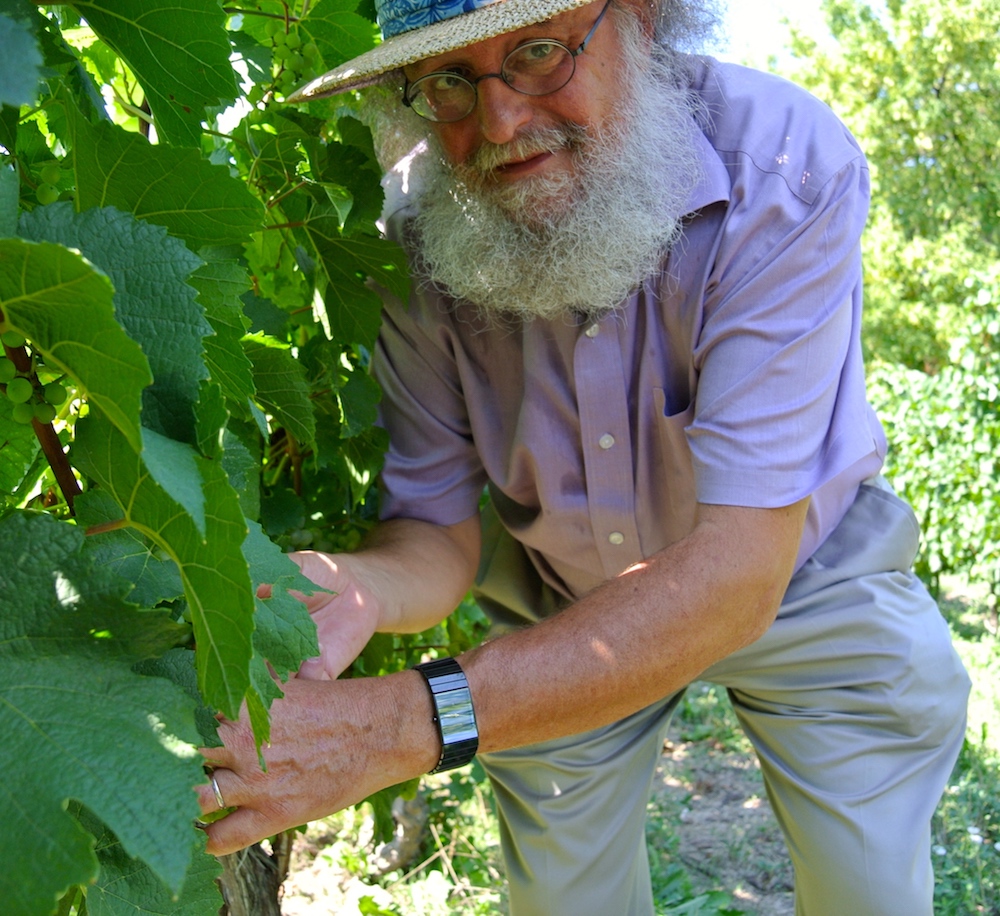
That base wine took its place beside four other vintages of Stratus sparkling wine with the first one, the 2012, scheduled to be released first.
As fate would have it, the 2012 vintage will be released when it’s ready after the debut 2013 vintage. The Blanc de Blancs, grown in a tiny corner of the Stratus Vineyard (behind Oast House Brewers and planted originally in 1992), has been made in every vintage since 2012 except in 2018 (but a double allocation is being made in the 2019 vintage).
Today, like a proud papa, Groux revealed the culmination of all those years of trials, tasting and patiently waiting, his very first vintage of the Stratus Blanc de Blancs Méthode Traditionelle 2013. It is worth every minute of waiting. What a stunning wine.
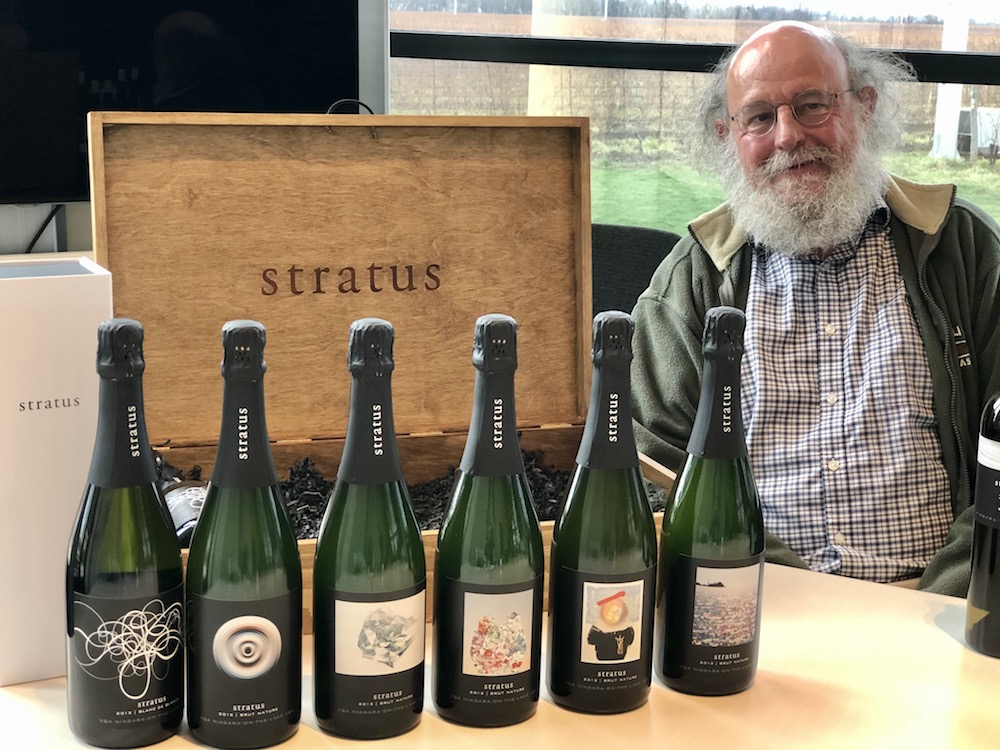
The 2013 vintage is being released before the 2012 vintage as Groux felt the warmer vintage needed extra time on the lees. The 2013 is available beginning tomorrow (Thursday) at Stratus with a Brut Nature 2013, made from the same grapes and the same way but bottled on its lees and with zero dosage, available as of Dec. 6 in six packs. The Blanc de Blancs has only 1 g/l of RS added to the final wine as a top up, and that is it. The Brut Nature has ZERO g/l.
Making these kinds of sparkling wines is not for the faint of heart or those who need to see the fruit of their labour turned quickly into cash. But when the owners at Stratus understood what Groux was trying to do with his first sparkling wine, and got a first taste of the trial wines, they exclaimed: “We want more.” Groux’s long journey of making classic bubbles was off to the races — well, more like a marathon.
Groux is in that most unique position with Niagara sparkling wines. He not only helped pioneer the modern era of sparkling wines in Ontario as part of the winemaking team at Trius (then called Hillebrand) in 1988 when he knew of only one other traditionally-made sparkler being made (Chateau des Charmes), but he is also part of the second coming of Ontario sparkling winemakers, in fact, Canadian winemakers, re-energizing the craft of sparkling wines — and in particular, traditionally made, or Methode Champenoise, made famous in the vineyards of Champagne, France, in the early 1600s.
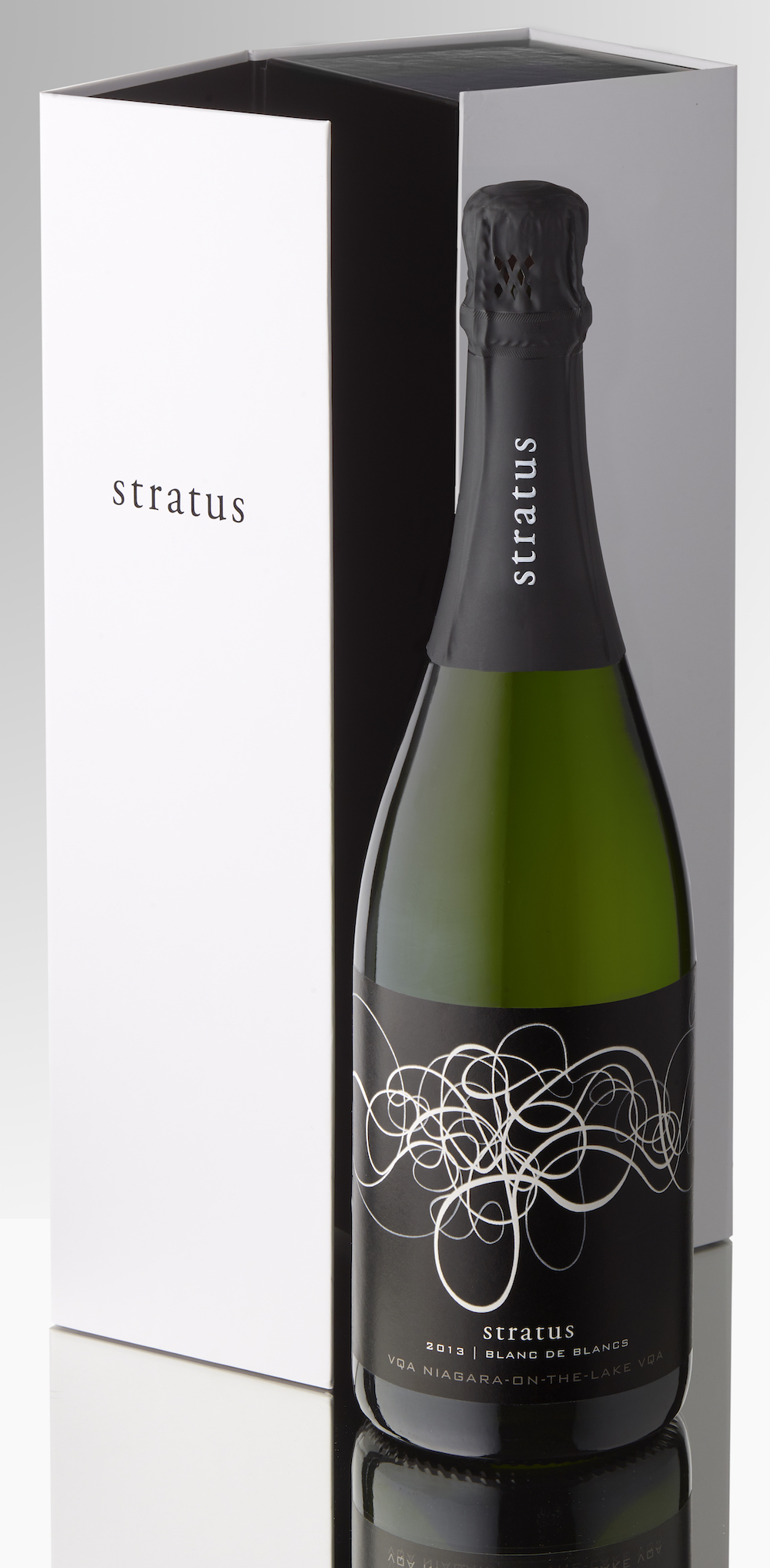
As with all the wines Groux makes, with meticulous blending and contemplation from the top down, his small production Blanc de Blancs — 140 six packs and 40 six packs of the Brut Nature that has five of those wines, each with its own Canadian artist label plus one bottle of Blanc de Blancs in a wooden crate — has been carefully thought out. He began growing and researching “sparkling” grapes in 2006, severing off a portion of the Chardonnay vineyard and leaving the canopy on the vines to shade the grapes and picking a full month before the other Chardonnay grapes.
Seven years on the lees is a long time, but for Groux it is not “that we want maximum lees, it’s the complexity we want,” he says. It’s made in the traditional style but it’s fully and completely a “Niagara Blanc de Blancs,” he says, with a nod to Champagne and some of the methods they use to grow and make what is arguably the world’s greatest expression of bubbly. It begins with the grapes, picked early with low brix (sugar) and bracing acidity in what Groux calls “low flavours. I don’t want tropical fruit or lime. The aromatics will build on the lees. We (are making) a style that’s complex and interesting. But we are in Niagara, it will always be Niagara.”
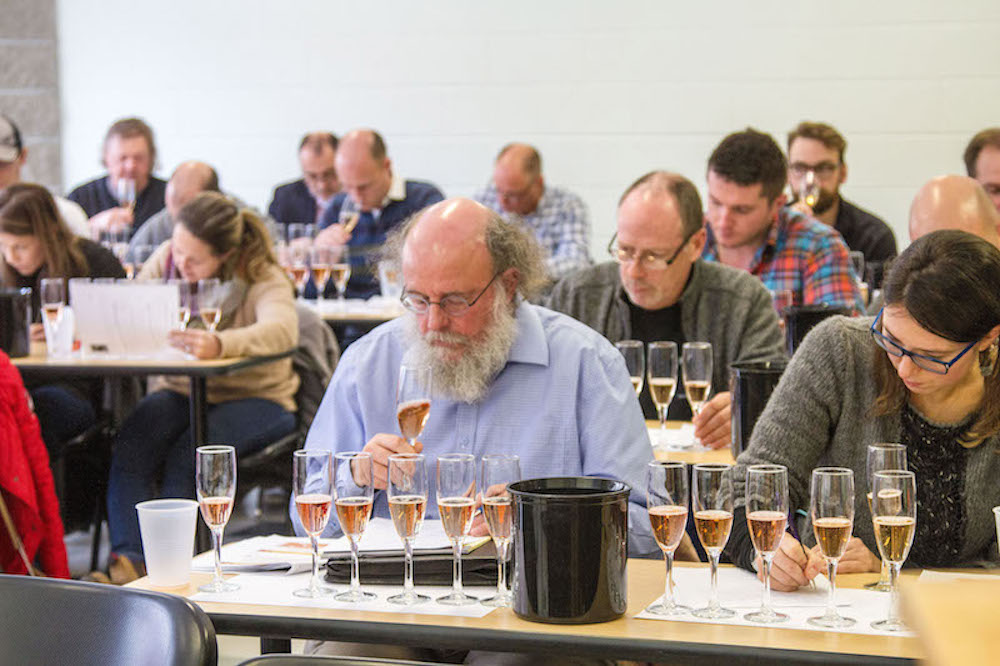
Unlike Champagne growers, Groux, seen above during a Fizz Club session at Brock, can pick when he wants and farm as he sees fit to make the very best sparkling wine he can. He wants high acidity in the grapes, so he leaves a big canopy on the vines and prunes the vines to grow tall. Groux only wants the best juice and he declassifies the first 40% and takes the rest for the sparkling wine. “We are more focused on quality then quantity,” he says.
While the traditionally made Blanc de Blancs at Stratus will always play the lead role in the sparkling program, aside from the 2013 Brut Nature there’s also an ancestral method Chardonnay in the works. As Groux told us Wednesday, “Stratus was never to be a powerhouse sparkling winery.”
After tasting these new wines, I have a feeling Stratus will be taking a spot among Niagara’s best sparkling producers — like it or not!
Here’s what I liked from the two sparkling wines being released Thursday. We also tasted a selection of other new Stratus wines, including the top assemblage Red and White from 2017, but will post those reviews in a separately.

Stratus Blanc de Blancs Méthode Traditionelle 2013 ($75, available at the winery or online beginning Thursday, 95 points) — Made from 100% Chardonnay and aged for six years on the lees (disgorged in January), this is all about elegance and finesse, and, my, what a gorgeous sparkling wine that shows a subtle yet persistent bubble in the glass and a fresh entry on the nose with lemon tart, perfumed apple notes, grapefruit, saline minerality, pretty floral accents and a lovely toastiness that builds in intensity as it breathes. The palate tingles from the finesse and freshness and a more generous mousse evolves into an elegant creamy texture showing green apple, citrus and pear with subtle biscuit notes, minerals and an energetic and lavishly finessed flare on the finish. I sense this will just keep getting better and better if you can save a bottle or two. It has a completely dry but not too austere profile that will gain some richness and fat in the bottle. Would love to see this wine in five years, but certainly attractive right now. As mentioned, only 140 six packs available.
The Brut Nature Artist Label Series
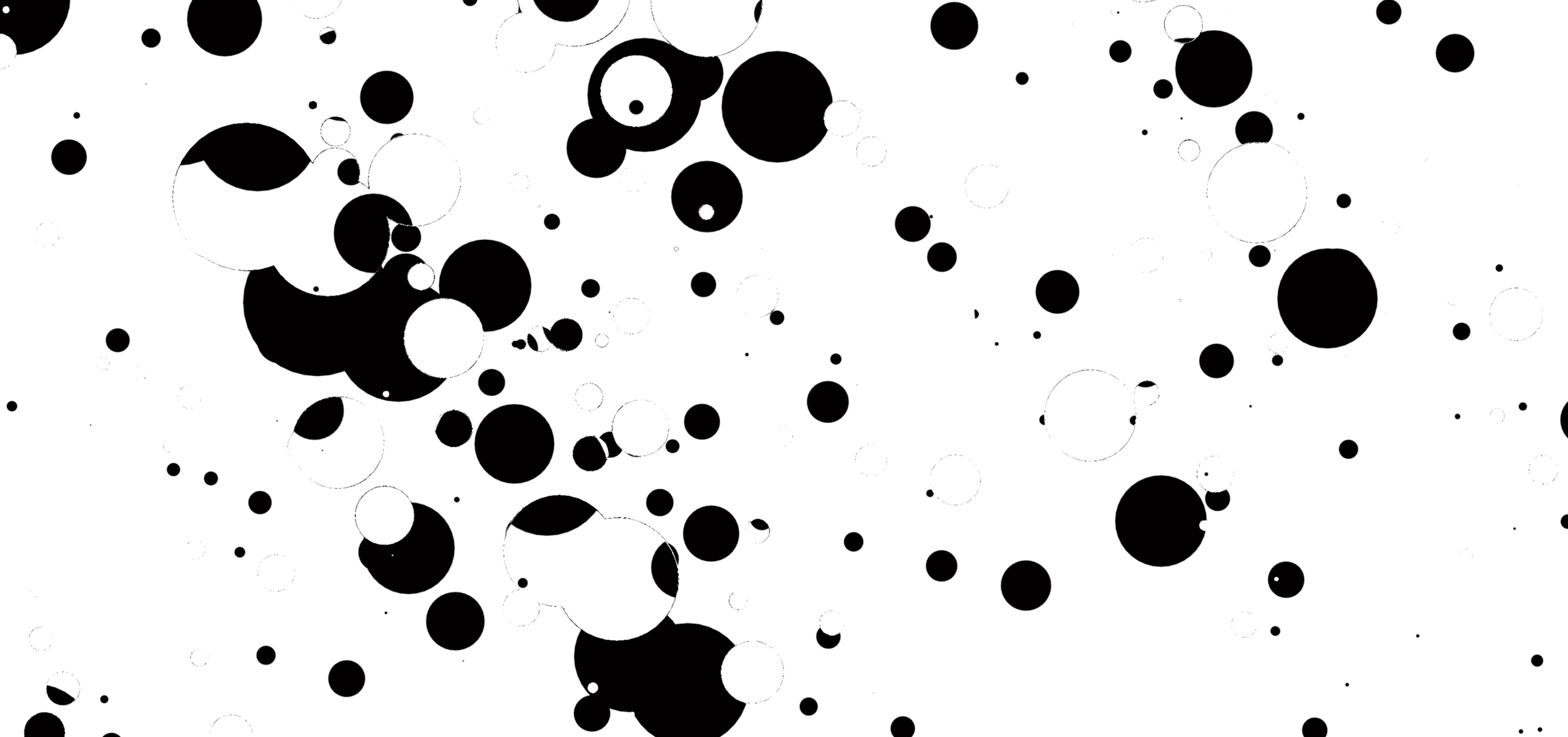
Stratus is celebrating the launch of their first-ever méthode traditionelle sparkling wines with the creation of a very limited collection, labelled with unique Canadian works of art.
The six-bottle wooden case includes both a Blanc de Blancs and Brut Nature made from 100% estate-grown Chardonnay. With only 40 boxes available, allocations will be selected by lottery. The six packs, $600 each, will go on sale as of Sunday Dec. 6 and the allocations drawn on Dec. 10.
Five celebrated artists from across Canada were invited to submit multiple works. The art was reviewed by a jury, drawn from the art, design and wine worlds, who selected one piece per artist. While the original intent was to have one final artwork chosen to label the entire wine lot, it was later decided to feature all five selected pieces based on the diversity and range of the submissions. With so few bottles exhibiting each artists’ work, the six-bottle collections are a stunning and rare showcase of Canadian talent, according to a news release.
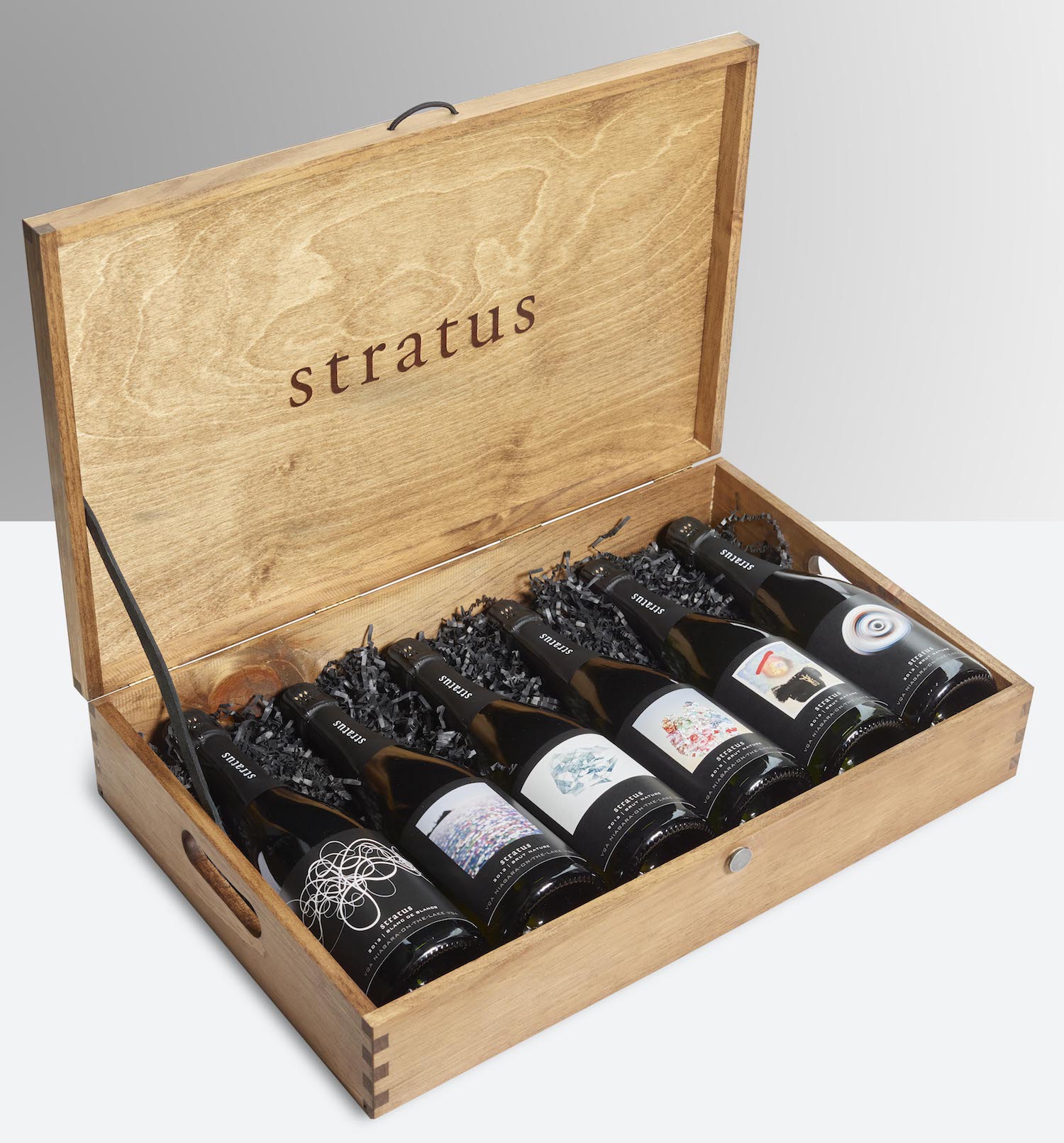
The sixth bottle within the collection is a Blanc de Blancs, Méthode Traditionelle and features the hallmark painting by the late Richard Halliday, which hangs in the Stratus tasting room. “Constellation Series has been an integral backdrop to our guest experience,” says Suzanne Janke, Estate Director at Stratus. “We are honoured to include Halliday’s iconic work with this much anticipated wine launch.”
The Artist Label Series is the culmination of the long-time vision of David Feldberg, founder and owner of Stratus and CEO of Teknion, a Canadian workplace furniture company. His passion for design and his love for wine mesh beautifully; and while not an original concept (the most famous art labels are from Château Mouton Rothschild, Bordeaux, France), the Artist Label Series is an opportunity to engage the Canadian art community. Winery friend and art collector Paul Bain, Board Chair, Toronto Biennial of Art and partner at Dickinson and Wright LLP, was the keystone connecting the winery and the Canadian art community, making Feldberg’s dream a reality. “I was thrilled to help my friends at Stratus. They make beautifully realized wines and this first sparkling product deserves memorable labels, which these great artists delivered,” comments Bain.
The featured artists are from five different provinces and span a variety of media, from painting, to works on paper, to photography and video. Melanie Authier, Jessica Eaton, Sarah Anne Johnson, Scott McFarland and Curtis Santiago have contributed a range of art which adds more ‘story’ and personality to the wine experience. Each original work was to be auctioned off at a launch event, but given COVID restrictions, this program has been postponed. The wine collection will be available on Dec. 6 by ‘lottery’, while each artist label was revealed daily, from Dec. 1 to 5 via Stratus’ social media and digital platforms.
Stratus Brut Nature
Stratus Brut Nature 2013 ($600 and only 40 six-bottle sets are available in a gorgeous wooden crate that includes five Brut Natures, each with its own Canadian artist label, and one bottle of the Blanc de Blancs, available from Dec. 6 by lottery, 94 points) — The same wine as above, but this is bottled with the lees and has zero dosage. Groux feels this will age longer than the Blanc de Blancs and keep gaining complexity as it sits on the lees. Essentially, it’s already six years on the lees and gains another year of lees aging annually — the ultimate sparkling do-it-yourselfer! The extra year of lees aging has brought the fruit along a bit on the nose with a more overt nose of golden apple, a mélange of citrus fruits, saline minerality, toasted almonds and creamy notes. Such elegance, austerity, vitality and freshness on the palate with citrus, apple, brioche/leesy notes, a creamy texture yet dry and finessed with a persistent bead in the glass. Such length and a subtle chalky accent on the finish. Another beauty.
The Five Artists
MELANIE AUTHIER
Blanket
2019 | Watercolour and Ink on Paper
Melanie Authier’s paintings careen between chroma and form, pulling us into an immersive space where nothing is static, and the only constant is contrariety. Treating the paper as a mnemonic record of movement, Authier stands her perpetual play of painterly oppositions on its head, charging various polarities into action, and illuminating the point of its pivot. The work lurches between synthetic and organic form, technological and natural eruption; meanwhile Authier plumbs geological depths and ascends to heavenly atmospheres. Between these various poles, she wields a masterful agitation, especially among her perspectival planes. She stokes our fathomage of where painting can take us.
Growing out of her past examinations with the dialectical baroque, Authier shifts into a more subdued approach to color. Forever rooting into the brush, each painting “sets up a problem,” with Authier working through the possibility of irresolution as her response. As such, her work churns up art’s freighted histories, as she shifts her weight between chaos and control.
Authier’s works bring viewers into a caterwaul of form, but also of competing histories. Citing High Modernist Abstraction in both her hard-edge and gestural painting, she positions herself at the interstices of a visual contradiction. By taking advantage of the possibilities of paint to function both as surface and space, she assigns marks their own degree of legibility as they get discovered along the spectrum between abstraction and representation. “My work references and, at times, wrestles with the after-burn of painting’s past, art history with a capital ‘A’,” she reflects. “So my preoccupying question is, ‘Where do we go from here?’”
Authier was born in Montreal and received a BFA from Concordia University (2002) and an MFA from University of Guelph (2006). She has had a seven venue national touring solo exhibition curated by Robert Enright (publication); and group shows at Arsenal Contemporary in New York; Ottawa Art Gallery; Galerie de l’UQAM; the National Gallery of Canada; and The Canada Gallery, Canada House, London, UK. Authier currently lives and works in Val-des-Monts, Quebec.
“A glass of sparkling wine is best enjoyed in conversation with another in front of a painting, amidst the crowd of an exhibition, in a moment of mutual rapport. So, wine, as with art, is best appreciated in good company and with good friends.”
— Melanie Authier
JESSICA EATON
Revolution 34
2018 | Pigment Print
“An ongoing theme in my work is the exploration of the ways a camera might be able to ‘see’ that differs from our vision system. The Revolutions works combine both a long shutter speed and additive colour separation. In these works the camera perceives an alternate idea of both time and colour processing.”
Jessica Eaton was born in Regina, Saskatchewan and attended Emily Carr University of Art and Design in Vancouver for her BFA Photography. She has had solo shows at Contact Photography Festival in Toronto and The Photographers’ Gallery, London, UK; and group shows at Fotografiemuseum Amsterdam; Presentation House Gallery, Vancouver; Musée d’art contemporain de Montréal; and Daegu Photography Bienniel, South Korea. Eaton is a 2019 Guggenheim Fellow.
“For myself, my best work is when I come in with a very strong idea of what I want things to be but then I am confronted with obstacles and I’m able to respond and negotiate and end up somewhere that defies and exceeds my initial idea. I believe there is a fundamental similarity to making, to producing, anything. It is an ongoing balancing of your will and external forces. I’ve had the privilege of watching people try to make wine. It is a beautiful process. You start with a grape and an idea but then have to adapt to what is actually happening. Perhaps just a slight shift in temperature changes everything.”
— Jessica Eaton
SARAH ANNE JOHNSON
Painted Hands
2019 | Pigment Print
“My work is generally about the influences outside forces can inflict on an environment and also how an environment can inflict forces on our psyche. With these images I made for Stratus, I was trying to make something more graphic and contained than I usually do. I was thinking about how important wine is to my life! How it’s a part of every celebration and gathering I have ever been to. How it can instantly help me to relax after a rough day. Lastly how making wine is itself a form of art. I tried to make pictures that conveyed these thoughts. I was thinking about the hands that make wine and the hands that make art.”
Sarah Anne Johnson was born, and currently lives, in Winnipeg, Manitoba. She received her BFA from the University of Manitoba and completed her MFA at The Yale School of Art, where she has also taught photography. Johnson’s work is included in many Canadian and international public collections including the Guggenheim Museum, New York; Art Gallery of Ontario, Toronto; and the National Gallery of Canada, Ottawa. Her work has been exhibited at The Metropolitan Museum, NY, the Art Gallery of Ontario, and MASS MoCA, among many others.
I suppose wine and art are a lot alike but in completely different ways. – Sarah Anne Johnson
SCOTT McFARLAND
Lake Effect Light with Colour Channel Separations
2019 | 4K Video “Still”
This “still frame” is selected from an original artwork video. Created out front of a lake cottage in Ontario, it depicts seamlessly forever-looping moments of sparkle and refraction on water during a seemingly endless summer afternoon. Slightly out of focus, the viewer can enter into its dream-like calm-minded state increased by the slow motion effect of light flickering across the scene. Multiple frames of video footage are layered onto transparencies, each of different colour palettes.
Scott McFarland lives and works in Toronto, Ontario. He has had solo exhibitions at the Art Gallery of Ontario in Toronto, The National Gallery of Canada in Ottawa, as well as the Vancouver Art Gallery. His works have been exhibited and are included in a number of public museum collections including; San Francisco MoMA, MoMA New York, and the Victoria and Albert Museum, London.
“I have often sat out looking at this exact view with a glass of wine in the afternoon and wanted to share something about that experience.”
— Scott McFarland
CURTIS TALWST SANTIAGO
The Poet
2018 | Spray Paint, Watercolour, Charcoal, Oil on Paper
“Inspired by new surroundings at the time I made this piece. I had just relocated to Lisbon, Portugal, to continue my research of Moorish history. I was granted access to the Castle of Almourol. Later in my studio, thinking of the lives that inhabited that space, I drew The Poet.”
Curtis Talwst Santiago was born in Edmonton, Alberta and apprenticed with indigenous artist Lawrence Paul Yuxweluptun after attending Emily Carr Fine Arts (Drawing and Painting). He has exhibited internationally at The Drawing Center, the FLAG Art Foundation and The New Museum in New York; The Eli and Edythe Broad Museum at Michigan State University; the Institute of Contemporary Art in Virginia; the Pérez Art Museum in Florida; The SCAD Museum of Art in Georgia and in Canada at the University of Saskatchewan; and the Art Gallery of Ontario. His work is in the permanent collection of the Studio Museum in New York.
My time in Portugal brought a new appreciation and love for wine. Often in the evening, new friends would come by the studio bringing a bottle to share. It became the perfect way to unwind after a day of living in my head.
— Curtis Talwst Santiago


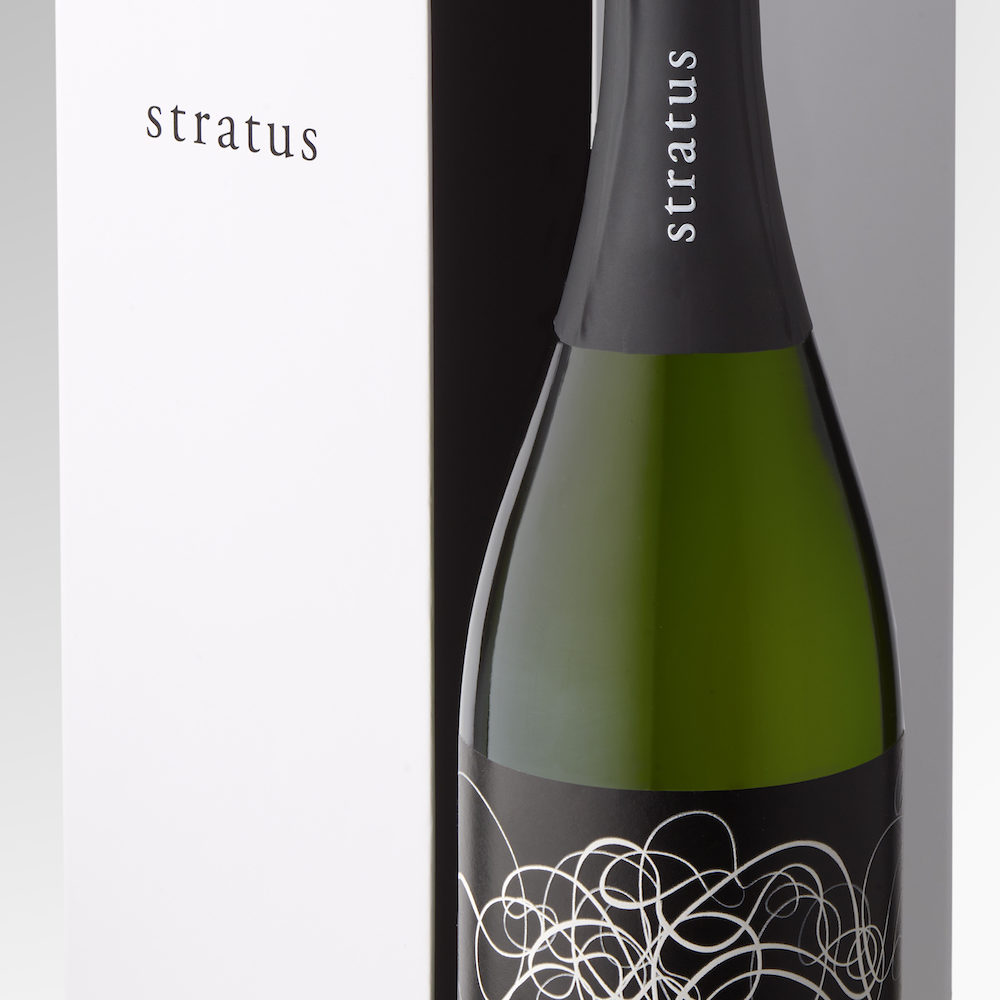




Comment here